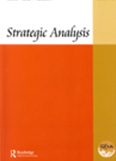Explaining China’s India Policy
Let the fact speak for itself. China was not happy about India gaining the waiver in the Nuclear Suppliers Group (NSG) and it played the role of a spoiler till such time it could. The Indian Government now feels betrayed. Perhaps India expected China’s reciprocity in exchange for its gracious support for the successful tour of the Olympic Torch. Indeed, it was naiveté that led India to believe Chinese rhetoric.
- Abanti Bhattacharya
- September 17, 2008






